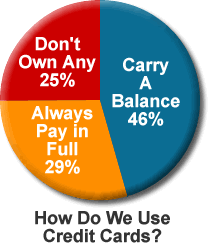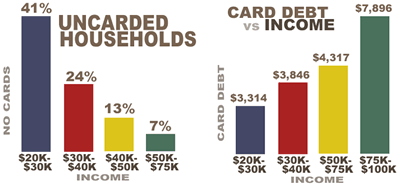 You’ve probably heard that the average American has over $8,000 of credit card debt. It’s been quoted all over the place. But does that single stat accurately explain the whole picture?
You’ve probably heard that the average American has over $8,000 of credit card debt. It’s been quoted all over the place. But does that single stat accurately explain the whole picture?
A popular source of this data is CardWeb Inc., which tracks such credit card data. Let’s take their 2002 data, which says that American households had average credit card debt of $8,940. Wow! But look closer. This figure is arrived at by dividing total credit card debt outstanding at the end of 2002 ($750.9 billion) by the number of American households that have at least one credit card (84 million). So not only are you counting balances that will be paid in full within the grace period, you are also only dividing by just the households that have a credit card. There are 21 million families with no credit cards at all.
Instead, I think you should only take the the amount of debt that Americans actually paid interest on, and divide it by all American households. To me, this is a more accurate definition of “average credit card debt per American”. This is $612 billion divided by 105 million, or $5,829 per household. And that’s not all.
 Another source of information is the Federal Reserve’s Survey of Consumer Finances (SCF). Here, the 2004 survey found that the average (mean) balance for those carrying a balance was $5,100, but the median was only $2,200. The large difference between the mean and median values indicates that the debt is not spread around equally – a small amount of borrowers have the majority of the debt. In addition, only 46% of families actually carried a balance, and 25% of families don’t even have any credit cards at all.
Another source of information is the Federal Reserve’s Survey of Consumer Finances (SCF). Here, the 2004 survey found that the average (mean) balance for those carrying a balance was $5,100, but the median was only $2,200. The large difference between the mean and median values indicates that the debt is not spread around equally – a small amount of borrowers have the majority of the debt. In addition, only 46% of families actually carried a balance, and 25% of families don’t even have any credit cards at all.
Now, what is the relationship between debt and income level?

(This is actually based on Cardweb data, but the SCF data is very similar.)
Here, we see that as income increases, people are more likely to both use credit cards and also carry higher balances. But from a recent Gallup poll, while the overall debt-to-income ratio among credit card holders is 8.0%, it is over 10% among people earning less than $40,000 a year, and much smaller among people with higher incomes.
Also, I observed that the Federal Reserve total debt numbers are lower than the Cardweb numbers, but the other stats like card ownership and the distribution vs. income are very similar. I suspect that one major reason for this is the self-reported nature of the SCF: People are underestimating their debt due to either denial or embarrassment. So that $2,200 number above may be higher in reality, but still not as high as $5,000 or $9,000.
Summary
On one hand, you cannot refute the fact that credit card debt is indeed a huge problem for many families. Any way you cut it, $612 billion is a big number. And the families with the highest debt-to-income ratios are earning less than $40,000 a year. I think better education and more transparency in credit applications should be implemented.
However, many of the sound bites thrown around about credit cards are very misleading. The majority of households don’t pay any credit card interest at all. None. Zero. Zilch. Of the families that do carry a balance, the median amount owed is in the neighborhood of $2,000-$3,000. Paints a different picture, doesn’t it?
(Yes, people like me who profit from credit card debt probably skew the stats a little tiny bit as well. 😛 )
References
The idea for this post was taken from an older MSN Money article, which used 2001 data. You can find the 2004 Survey of Consumer Finances here, and the Cardweb data here.
 The Best Credit Card Bonus Offers – 2025
The Best Credit Card Bonus Offers – 2025 Big List of Free Stocks from Brokerage Apps
Big List of Free Stocks from Brokerage Apps Best Interest Rates on Cash - 2025
Best Interest Rates on Cash - 2025 Free Credit Scores x 3 + Free Credit Monitoring
Free Credit Scores x 3 + Free Credit Monitoring Best No Fee 0% APR Balance Transfer Offers
Best No Fee 0% APR Balance Transfer Offers Little-Known Cellular Data Plans That Can Save Big Money
Little-Known Cellular Data Plans That Can Save Big Money How To Haggle Your Cable or Direct TV Bill
How To Haggle Your Cable or Direct TV Bill Big List of Free Consumer Data Reports (Credit, Rent, Work)
Big List of Free Consumer Data Reports (Credit, Rent, Work)
I’ve often wondered about that $8,940 figure–if it was indeed accurate. I think the danger in that is people thinking, “oh, I’ve only got $4,000 in debt–I must be doing okay compared to other people!” Thanks for clarifying.
Great, thoughtful post! Nice to hear the other side of the statistics.
That is great analysis. It doesn’t seem nearly as dire as the common soundbite makes if sound. I always imagined those households that must have been carrying $20,000+ in credit card debt to offset those of us that have a zero balance.
Then there are those people like you that skew the number as well. If someone saw your credit card balances, they’d think you are crazy. (Good thing you always note that the credit card balance is the zero percent game when you post your net worth. 🙂 )
This is an excellent post and very thoughtful analysis.
However, the data I take away from it is that 46% of American choose to live in debt and beyond their means or alternatively are not sophisticated enough to understand that they are needlessly paying exhorbintant amounts in interest.
I have large credit card balances but they are always paid in full when the bill comes. I only paid interest on credit cards just once in twenty something years…just to feel what it was like..and never did it again…
Nice post. Thanks.
Great post! I probably skew the stats a tiny bit too by carrying a $25K balance.
The way I see it, if people choose to finance some consumer goods with a credit card and spread out the payments in exchange for paying interest, that is their decision. People take out loans for cars all the time, and most cars have a large component that is not a “need” but a “want”. We’ve just been conditioned to see that as an acceptable practice.
Also, if you make more money, then you can finance more safely, if you want. Of course it’s still a bad deal mathematically – you’re basically jacking up the price of the goods on yourself.
I think the percentage of people who should really be concerned about their situation is less than 10%. But it can be a very bad spiral for those who get in over their head.
I’m assuming we are only talking about credit card debt here. I am wondering about average debt loads for large-scale purchases (e.g. cars, homes, etc) that higher-income families take 2nd mortgages, HELOCs for? Some of these loans are defaulting because these families are living beyond their means and not considering these purchases from a cash flow perspective. I think that this problem is the same along any income level, it’s just the number of zeroes on the check.
I suspect that the problem is larger than 10% if you add in other types of debt. And I’m assuming we’re just talking about credit card debt here. But what about debt for large-scale purchases that higher-income families use? These 2nd homes, investment homes, 2nd mortgages and HELOCs propel these families beyond their means since they are not looking at these “investments” from a cash flow perspective. This problem is spread across all income levels, it’s just the number of zeroes on the check.
Jonathan mentioned that a small number of people have very large debts. I know a guy that hits the limit on the number of miles he gets through his credit card. I could not imagine how he could spend soooo much money. So one day I asked him how he got so many miles. He is a dentist and owns property. Most of his purchases for his businesses are made on his credit card (for the perks). In addition, my company has given everyone credit cards and we have to charge everything (at least everything possible) on these cards during a buesiness trip. We get amonishments if we don’t… (and btw, charges on these cards for personal expenditures gets you fired even if you and not the company pays for the charges!! I know people who have been fired.) So both of these things would raise credit card debt. Are these included in the consumer debt number because most people would not think of these items as “consumer debt”.
Consumer debt and the lack of saving in general is a big problem of course, but I haven’t dug through all the stats, so I’m just focusing on the credit card side of the picture here.
i always learn something new when i come to your blog. 🙂
As Hazzard suggested, there must be some further upward skewing of even the $5,829 figure by those of us strategically using 0% debt to make money.
It would be interesting if a study provided a figure excluding anyone who carries a balance but pays no interest.
I am in the category that pays in full every month. I have a major gas company card I use that gives 5% cash refund for gas purchases. The credit is automatic and easy.
I’m way too lazy to keep up with points or rewards and finding the cheese in the maze. I have other things to worry about, like living my life.
Very interesting that things are not as bad as reported. That $8900 number is an example of fuzzy math if I’ve ever seen it.
very nice visual chart.
I would figure that as income goes up, at least to a certain point, that actual credit card debt would drop dramatically. At elast I would think that they would be the least likely to carry a balance on cards.
The numbers definietly become skewed, with some people having no debt and others being very very indebted. This can bring the average up.